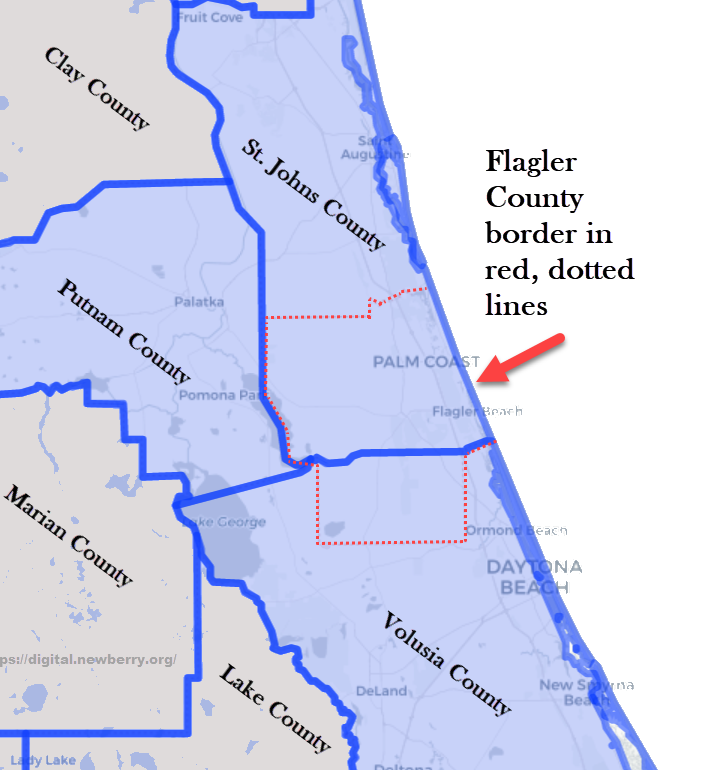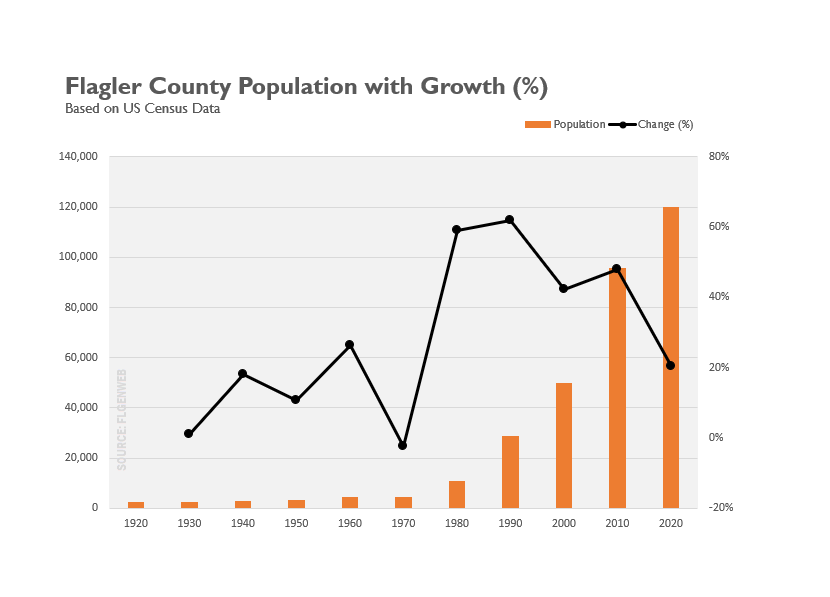History of Flagler County
Early History
The area now known as Flagler County was originally inhabited by the Timucua people, who lived in the region for thousands of years before the arrival of European explorers. This resulted in military action, which is detailed in the Early Military History.
The city of Bunnell in Flagler County is one of the oldest communities Florida's Atlantic Coast. Originally known as Bunnell Stop, it was founded in 1909 and named for Alvah A. Bunnell. The Town of Bunnell was incorporated in 1913, but its history as a community dates back to the 1880s. The City of Bunnell was officially incorporated in 1924. Bunnell, like many of Florida's Atlantic Coast communities and cities, owes it beginnings to the railroad system
Growing Area
- In 1903, Bunnell had grown large enough to warrant a United States Post Office.
- Isaac I. Moody, J. R. Sloan, and James Frank 'Major' Lambert started a land development company called The Bunnell Development Company in 1909. That company became the foundation of today's Bunnell. The town was quickly platted and lots were selling briskly, bringing new residents to the area.
- 1909 saw the first permanent home erected, it was built by the Bunnell Development Company for James Frank 'Major' Lambert. 1909 also saw construction of the very first church in Flagler County, The First United Methodist of Bunnell.
- The Bunnell First State Bank opened it doors in 1910.
Founding of Flagler County
Flagler County was created in 1917 when portions of St. Johns and Volusia counties were combined. The county was named after Henry M. Flagler, a prominent businessman who played a major role in the development of Florida's east coast.
Flagler is responsible for much of Florida's growth due to his vision and construction of a railroad system for much of the east coast. His first venture was in constructing a rail from the mainland to Key West. He also was involved in real estate and built several St. Augustine hotels. His empire was shared by helping hospitals,churches and schools come into existence.

How the County was Divided
Growth and Development
In the early 20th century, Flagler County was primarily a rural area with a few small towns. However, the construction of the Intracoastal Waterway and the opening of the Florida East Coast Railway brought new opportunities for growth and development.
Although the beaches and outdoor activities are what one thinks of when you mention a county on the beach, agriculture is also a large part of the land usage. Crops of cabbage, potatoes, pepper, squash and blueberries dot the country side. One can also see cows and goats grazing. Not so different from our ancestors lives in the area. Perhaps just the methods have improved.
1920 County Officers
There are county officers.
-
County Seat — Bunnell
County Judge — W. Lee Bartlett
Sheriff — E. E. Johnston
Clerk Circuit Court — J. C. Geiger
Superintendent Public Instruction — Ed. Johnson
County Assessor of Taxes — Adolph Deen
Tax Collector — C. E. Pellicer
Supervisor of Registration — Robert L. Harper; term expires in July, 1922.
-
County Commissioners.
District No. 1 — Geo. Moody, Bunnell
District No. 2 — G. A. Pacetti, Dupout
District No. 3 — Robt. Hamilton, Bunnell.
District No. 4 — Z. G. Holland, Bunnell.
District No. 5 — Z. W. Richardson, Espanoln. (Re-signed February 16, 1920, and Alsey J. Eatman, of Espanola, commissioned May 21, 1920, until next general election.)
-
County Board of Public Instruction.
District No. 1 — F. L. Byrd, Bunnell.
District No. 2 — W. E. Knight, Bunnell.
District No. 3 — I. H. Friar, Bunnell.
-
Justices of the Peace.
District No. 1 — Michael Stone, Bunnell. (Resigned August 2, 1920, and Fred A. Rich, of Bunnell, commissioned September 20, 1920, until next general election.)
District No. 2 — Irvin W. Howard, Dupont. (Resigned August 16, 1920.)
-
Constable.
District No. 2 — J. E. Deen, Dupont.
-
Game Warden.
W.H. Faulk, Dupont. (Suspended August 12, 1920.)
County Population Growth
The population data provided illustrates the changes in population over the course of a century. Starting from a modest 2,442 in 1920, the population steadily increased, with varying growth rates throughout the decades.
Notable periods of rapid growth occurred in the 1980s and 1990s, where the population surged by 59.2% and 62.0%, respectively. These decades witnessed significant societal and economic changes that likely contributed to the population boom.
However, it is worth noting that not all years saw an upward trend. The 1970s, for instance, experienced a slight decline of 2.5% in population. In recent years, although the population continues to grow, the rate of increase has slowed down, with a 20.4% change observed between 2010 and 2020.
This data suggests a complex interplay of various factors, such as birth rates, immigration, and economic conditions, influencing population dynamics. Understanding and monitoring population trends are crucial for addressing social, economic, and infrastructure challenges in order to sustainably accommodate the needs of a growing population.

